View in other NatureServe Network Field Guides
NatureServe
Montana
Utah
Wyoming
Idaho
Wisconsin
British Columbia
South Carolina
Yukon
California
New York
Lovely Vallonia - Vallonia pulchella
Other Names:
Helix pulchella, Helix minuta, Vallonia minuta
General Description
A small shell, to about 2.5 mm diameter and 1.2 mm in height, flattened heliciform with fine incremental striae and occasional low wrinkles (not ribbed), about 3 to 3 1/2 whorls, not descending to the aperture. Shell coloration is translucent shiny white. Aperture lip thickened with a rib-like callus, lip flared abruptly outward; umbilicus about 1/4 the shell diameter. Animal is white (Hendricks 2012, Burke 2013). Internal anatomy is described by Watson (1920).
Diagnostic Characteristics
Combination of small size (< 3.5 mm diameter), flattened heliciform shape, flared lip, and color (translucent white to pale brown) separate Vallonia from other shells. A thickend lip distinguish V. pulchella and V. gracilicosta from V. cyclophorella and V. perspectiva. V. pulchella has occasional low wrinkles but is unribbed and shiny while V. gracilicosta has widely-spaced axial ribs.
Species Range
Montana Range
Range Descriptions
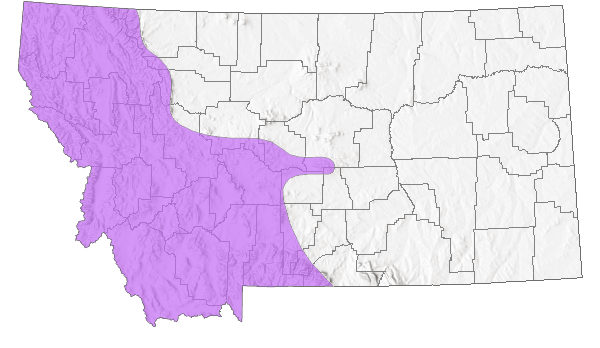
 Native
Native
Range Comments
Native to Europe, North Africa and northern Asia, and northern and central North America; apparently introduced across many areas of western North America (Burke 2013). In Montana, reported on both sides of the Continental Divide from five counties: Flathead, Lake, Missoula, Ravalli, Stillwater. Elevation range is 930 to 1588 m (3050 to 5210 ft). May be locally common; 18 live specimens were found at one Ravalli County site in early April (Hendricks 2012). Range and abundance in Montana poorly documented; current status needs investigation.
Observations in Montana Natural Heritage Program Database
Number of Observations: 9
(Click on the following maps and charts to see full sized version)
Map Help and Descriptions
Relative Density
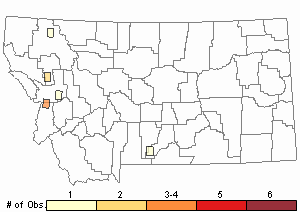
Recency

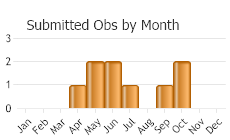
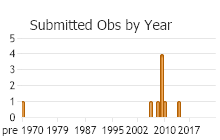
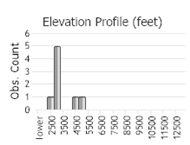 (Observations spanning multiple months or years are excluded from time charts)
(Observations spanning multiple months or years are excluded from time charts)
Habitat
Inhabits disturbed areas, such as gardens, parks and roadsides, often near moisture. Canopy species include Douglas-fir, ponderosa pine, black cottonwood, lodgepole pine, Engelmann spruce; secondary canopy includes alder and willow. Found under woody debris and rocks, and in leaf litter and duff (Beetle 1961, 1989; Forsyth 2004; Hendricks 2012). Habitat in Montana poorly documented.
References
- Literature Cited AboveLegend:
 View Online Publication
View Online Publication Beetle, D. E. 1961. Mollusca of the Big Horn Mountains. The Nautilus 74:95-102.
Beetle, D. E. 1961. Mollusca of the Big Horn Mountains. The Nautilus 74:95-102. Beetle, D.E. 1989. Checklist of recent Mollusca of Wyoming, U.S.A. The Great Basin Naturalist 49(4):637-645.
Beetle, D.E. 1989. Checklist of recent Mollusca of Wyoming, U.S.A. The Great Basin Naturalist 49(4):637-645. Burke, T. E. 2013. Land snails and slugs of the Pacific Northwest. Corvallis, OR: Oregon State University Press. 344 p.
Burke, T. E. 2013. Land snails and slugs of the Pacific Northwest. Corvallis, OR: Oregon State University Press. 344 p. Forsyth, R.G. 2004. Land snails of British Columbia. Royal British Columbia Museum: Victoria, British Columbia, Canada. 188 pp.
Forsyth, R.G. 2004. Land snails of British Columbia. Royal British Columbia Museum: Victoria, British Columbia, Canada. 188 pp. Hendricks, P. 2012. A Guide to the Land Snails and Slugs of Montana. A report to the U.S. Forest Service - Region 1. Montana Natural Heritage Program, Helena, MT. vii + 187 pp. plus appendices.
Hendricks, P. 2012. A Guide to the Land Snails and Slugs of Montana. A report to the U.S. Forest Service - Region 1. Montana Natural Heritage Program, Helena, MT. vii + 187 pp. plus appendices. Watson, H. 1920. The affinities of Pyramidula, Patulastra, Acanthinula, and Vallonia. Proceedings of the Malacological Society 14:6-30.
Watson, H. 1920. The affinities of Pyramidula, Patulastra, Acanthinula, and Vallonia. Proceedings of the Malacological Society 14:6-30.
- Additional ReferencesLegend:
 View Online Publication
View Online Publication
Do you know of a citation we're missing? Henderson, J. 1936. Mollusca of Colorado, Utah, Montana, Idaho, and Wyoming, supplement. University of Colorado Studies 23(2): 81-145.
Henderson, J. 1936. Mollusca of Colorado, Utah, Montana, Idaho, and Wyoming, supplement. University of Colorado Studies 23(2): 81-145. Pilsbry, H.A. 1948. Land Mollusca of North America (north of Mexico), Volume II Part 2. The Academy of Natural Sciences of Philadelphia Monograph Number 2(2): 521-1113.
Pilsbry, H.A. 1948. Land Mollusca of North America (north of Mexico), Volume II Part 2. The Academy of Natural Sciences of Philadelphia Monograph Number 2(2): 521-1113. Squyer, H. 1894. List of shells from the vicinity of Mingusville, Montana. The Nautilus 8:63-65.
Squyer, H. 1894. List of shells from the vicinity of Mingusville, Montana. The Nautilus 8:63-65.
- Web Search Engines for Articles on "Lovely Vallonia"
- Additional Sources of Information Related to "Snails / Slugs"





